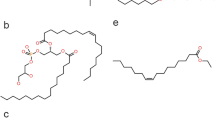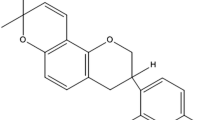Abstract
The present study aimed to develop a cucurbitacin B microemulsion (CuB-ME) and investigate the mechanism of the enhanced drug skin absorption at the molecular level. Firstly, the pseudo-ternary phase diagrams were developed to evaluate the effect of composition on microemulsion properties systematically. The formulation composition types and ratios of oil phase, surfactant, co-surfactant, and aqueous phase were optimized by an in vitro skin permeation experiment, and the optimized formula was confirmed with the pharmacodynamics study. Furthermore, the molecular mechanism of enhanced skin permeation was investigated using ATR-FTIR and molecular modeling. As a result, the optimized CuB-ME formulation was composed of Azone:Tween 80:ethanol:water = 2.5:16.9:5.6:75.0 (w/w/w/w). The oil phase improved skin permeation by disordering the stratum corneum intercellular liquid, while the aqueous phase impacted the particle size of the microemulsion and permeability coefficient of the drug. Besides, the hydration state of skin lipid also enhanced drug permeation by the interaction of water and the polar head of ceramide. The in vitro skin permeation amount was 45.47 ± 10.39 μg/cm2, and no significant skin irritation was observed. The pharmacodynamics study demonstrated that CuB-ME had a significant therapeutic effect on the animal tumor model. In conclusion, the CuB-ME was developed successfully and the effect of the oil phase and aqueous phase on drug skin permeation was clarified at the molecular level.










Similar content being viewed by others
References
Bray F, Ferlay J, Soerjomataram I, Siegel RL, Torre LA, Jemal A. Global cancer statistics 2018: GLOBOCAN estimates of incidence and mortality worldwide for 36 cancers in 185 countries. CA Cancer J Clin. 2018;68(6):394–424.
Hanahan D, Weinberg RA. Hallmarks of cancer: the next generation. Cell. 2011;144(5):646–74.
Yu M, Zhang C, Tang Z, Tang X, Xu H. Intratumoral injection of gels containing losartan microspheres and (PLG-g-mPEG)-cisplatin nanoparticles improves drug penetration, retention and anti-tumor activity. Cancer Lett. 2019;442:396–408.
Bashraheel SS, Domling A, Goda SK. Update on targeted cancer therapies, single or in combination, and their fine tuning for precision medicine. Biomed Pharmacother. 2020;125:110009.
Pasquali S, Hadjinicolaou AV, Chiarion Sileni V, Rossi CR, Mocellin S. Systemic treatments for metastatic cutaneous melanoma. Cochrane Database Syst Rev. 2018;2:CD011123.
Leach C. Complications of systemic anti-cancer treatment. Medicine. 2019;48(1):48–51.
Wiedersberg S, Guy RH. Transdermal drug delivery: 30+ years of war and still fighting! J Control Release. 2014;190:150–6.
Peters RR, Farias MR, Ribeiro-do-Valle RM. Anti-inflammatory and analgesic effects of cucurbitacins from Wilbrandia ebracteata. Planta Med. 1997;63(6):525–8.
Liu X, Duan C, Ji J, Zhang T, Yuan X, Zhang Y, et al. Cucurbitacin B induces autophagy and apoptosis by suppressing CIP2A/PP2A/mTORC1 signaling axis in human cisplatin resistant gastric cancer cells. Oncol Rep. 2017;38(1):271–8.
Chen JC, Chiu MH, Nie RL, Cordell GA, Qiu SX. Cucurbitacins and cucurbitane glycosides: structures and biological activities. Nat Prod Rep. 2005;22(3):386–99.
El-Senduny FF, Badria FA, EL-Waseef AM, Chauhan SC, Halaweish F. Approach for chemosensitization of cisplatin-resistant ovarian cancer by cucurbitacin B. Tumor Biol. 2015;37(1):685–98.
Chan KT, Meng FY, Li Q, Ho CY, Lam TS, To, Y, et al. Cucurbitacin B induces apoptosis and S phase cell cycle arrest in BEL-7402 human hepatocellular carcinoma cells and is effective via oral administration. Cancer Lett. 2010;294(1):118–24.
Zhang M, Zhang H, Sun C, Shan X, Yang X, Li-Ling J, et al. Targeted constitutive activation of signal transducer and activator of transcription 3 in human hepatocellular carcinoma cells by cucurbitacin B. Cancer Chemother Pharmacol. 2009;63(4):635–42.
Wang Z, Zhu W, Gao M, Wu C, Yang C, Yang J, et al. Simultaneous determination of cucurbitacin B and cucurbitacin E in rat plasma by UHPLC-MS/MS: A pharmacokinetics study after oral administration of cucurbitacin tablets. J Chromatogr B Anal Technol Biomed Life Sci. 2017;1065-1066:63–9.
Anselmo AC, Mitragotri S. An overview of clinical and commercial impact of drug delivery systems. J Control Release. 2014;190:15–28.
ElMasry SR, Hathout RM, Abdel-Halim M, Mansour S. In vitro transdermal delivery of sesamol using oleic acid chemically-modified gelatin nanoparticles as a potential breast cancer medication. J Drug Deliv Sci Technol. 2018;48:30–9.
Yehia R, Hathout RM, Attia DA, Elmazar MM, Mortada ND. Anti-tumor efficacy of an integrated methyl dihydrojasmonate transdermal microemulsion system targeting breast cancer cells: in vitro and in vivo studies. Colloids Surf B Biointerfaces. 2017;155:512–21.
Chen H, Chang X, Du D, Li J, Xu H, Yang X. Microemulsion-based hydrogel formulation of ibuprofen for topical delivery. Int J Pharm. 2006;315(1–2):52–8.
Lawrence MJ, Rees GD. Microemulsion-based media as novel drug delivery systems. Adv Drug Deliv Rev. 2000;45(1):89–121.
Talegaonkar S, Azeem A, Ahmad FJ, Khar RK, Pathan SA, Khan ZI. Microemulsions: a novel approach to enhanced drug delivery. Recent Pat Drug Deliv Formul. 2008;2(3):238–57.
Todo H, Tamura M, Uchida T, Kurumada M, Motoki A, Sano T, et al. Prediction of skin permeation of flurbiprofen from neat ester oils and their o/w emulsions. Chem Pharm Bull (Tokyo). 2018;66(10):959–66.
Podlogar F, Bester Rogac M, Gasperlin M. The effect of internal structure of selected water-Tween 40-Imwitor 308-IPM microemulsions on ketoprofene release. Int J Pharm. 2005;302(1–2):68–77.
Hathout RM, Mansour S, Mortada ND, Geneidi AS, Guy RH. Uptake of microemulsion components into the stratum corneum and their molecular effects on skin barrier function. Mol Pharm. 2010;7(4):1266–73.
Chen H, Chang X, Weng T, Zhao X, Gao Z, Yang Y, et al. A study of microemulsion systems for transdermal delivery of triptolide. J Control Release. 2004;98(3):427–36.
Zhang J, Michniak-Kohn B. Investigation of microemulsion microstructures and their relationship to transdermal permeation of model drugs: ketoprofen, lidocaine, and caffeine. Int J Pharm. 2011;421(1):34–44.
Davies DJ, Ward RJ, Heylings JR. Multi-species assessment of electrical resistance as a skin integrity marker for in vitro percutaneous absorption studies. Toxicol in Vitro. 2004;18(3):351–8.
Ceschel GC, Maffei P, Moretti MD, Demontis S, Peana AT. In vitro permeation through porcine buccal mucosa of Salvia desoleana Atzei & Picci essential oil from topical formulations. Int J Pharm. 2000;195(1–2):171–7.
Spears CP. Volume doubling measurement of spherical and ellipsoidal tumors. Med Pediatr Oncol. 1984;12(3):212–7.
Tolkamp BJ, Emmans GC, Yearsley J, Kyriazakis I. Optimization of short-term animal behaviour and the currency of time. Anim Behav. 2002;64:945–53.
Jianbo G, Xue L, Hongdan Y, Zhaohui T, Xing T, Chenchen C, et al. The anti-melanoma efficiency of the intratumoral injection of cucurbitacin-loaded sustained-release carriers: a PLGA particle system. J Pharm Sci. 2013;102(8):2550–63.
Obata Y, Utsumi S, Watanabe H, Suda M, Tokudome Y, Otsuka M, et al. Infrared spectroscopic study of lipid interaction in stratum corneum treated with transdermal absorption enhancers. Int J Pharm. 2010;389(1–2):18–23.
Rodríguez G, Rubio L, Cócera M, Estelrich J, Pons R, Alfonso DLM. Application of bicellar systems on skin: diffusion and molecular organization effects. Langmuir. 2010;26(13):10578–84.
Hasanovic A, Winkler R, Resch GP, Valenta C. Modification of the conformational skin structure by treatment with liposomal formulations and its correlation to the penetration depth of aciclovir. Eur J Pharm Biopharm. 2011;79(1):76–81.
Greve TM, Andersen KB, Nielsen OF. ATR-FTIR, FT-NIR and near-FT-Raman spectroscopic studies of molecular composition in human skin in vivo and pig ear skin in vitro. Spectroscopy. 2008;22(6):437–57.
Liu C, Farah N, Weng W, Jiao B, Shen M, Fang L. Investigation of the permeation enhancer strategy on benzoylaconitine transdermal patch: the relationship between transdermal enhancement strength and physicochemical properties of permeation enhancer. Eur J Pharm Sci. 2019;138:105009.
Potts RO, Golden GM, Francoeur ML, Mak VHW, Guy RH. Mechanism and enhancement of solute transport across the stratum comeum. J Control Release. 1991;15(3):249–60.
Diez-Sales O, Watkinson AC, Herráez-Dominguez M, Javaloyes C, Hadgraft J. A mechanistic investigation of the in vitro human skin permeation enhancing effect of Azone®. Int J Pharm. 1996;129:33–40.
Yang D, Liu C, Quan P, Fang L. A systematic approach to determination of permeation enhancer action efficacy and sites: molecular mechanism investigated by quantitative structure-activity relationship. J Control Release. 2020;322:1–12.
Yang D, Li W, Fang L, Liu C. Investigation of controlled release molecular mechanism of oil phase in spilanthol emulsion: development and in vitro, in vivo characterization. AAPS PharmSciTech. 2019;20(6):227.
Yuan Y, Li S, Yu L, Deng P, Zhong D. Physicochemical properties and evaluation of microemulsion systems for transdermal delivery of meloxicam. Chem Res Chin Univ. 2007;23(1):81–6.
Kreilgaard M, Pedersen EJ, Jaroszewski JW. NMR characterization and transdermal drug delivery potential of microemulsion systems. J Control Release. 2000;69(3):421–33.
Kreilgaard, M., Kemme, M.J.B., Burggraaf, J., Schoemaker,R.C., Cohen, A.F., 2001. Influence of a microemulsion vehicle on cutaneous bioequivalence of a lipophilic model drug assessed by microdialysis and pharmacodynamics. Pharm Res. 18 (5):593–599.
Williams AC, Barry BW. Penetration enhancers. Adv Drug Deliv Rev. 2004;56(5):603–18.
Liu C, Guan Y, Tian Q, Shi X, Fang L. Transdermal enhancement strategy of ketoprofen and teriflunomide: the effect of enhanced drug-drug intermolecular interaction by permeation enhancer on drug release of compound transdermal patch. Int J Pharm. 2019;572:118800.
Dai X, Shi X, Yin Q, Ding H, Qiao Y. Multiscale study on the interaction mechanism between ginsenoside biosurfactant and saikosaponin a. J Colloid Interface Sci. 2013;396:165–72.
Zhao H, Liu C, Quan P, Wan X, Shen M, Fang L. Mechanism study on ion-pair complexes controlling skin permeability: effect of ion-pair dissociation in the viable epidermis on transdermal permeation of bisoprolol. Int J Pharm. 2017;532(1):29–36.
Liu C, Quan P, Li S, Zhao Y, Fang L. A systemic evaluation of drug in acrylic pressure sensitive adhesive patch in vitro and in vivo: the roles of intermolecular interaction and adhesive mobility variation in drug controlled release. J Control Release. 2017;252:83–94.
Author information
Authors and Affiliations
Corresponding authors
Ethics declarations
The care and use of animals followed the NIH Guidelines for the Care and Use of Laboratory Animals, and all experiments complied with the criterion for animal use published by the Life Science Research Center of Shenyang Pharmaceutical University.
Additional information
Publisher’s Note
Springer Nature remains neutral with regard to jurisdictional claims in published maps and institutional affiliations.
Rights and permissions
About this article
Cite this article
Tian, Q., Guo, J., Zhang, Q. et al. Development and Evaluation of Cucurbitacin B Microemulsion: the Effect of Oil Phase and Aqueous Phase on Drug Percutaneous Absorption Based on ATR-FTIR Spectroscopy and Molecular Modeling. AAPS PharmSciTech 21, 258 (2020). https://doi.org/10.1208/s12249-020-01797-8
Received:
Accepted:
Published:
DOI: https://doi.org/10.1208/s12249-020-01797-8




